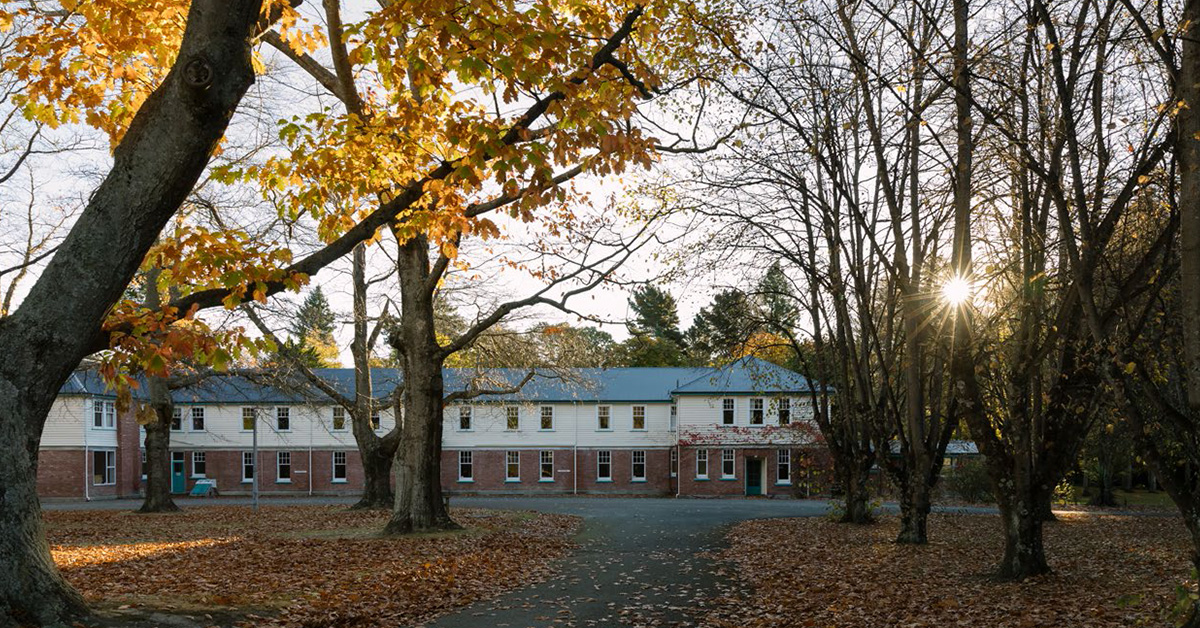
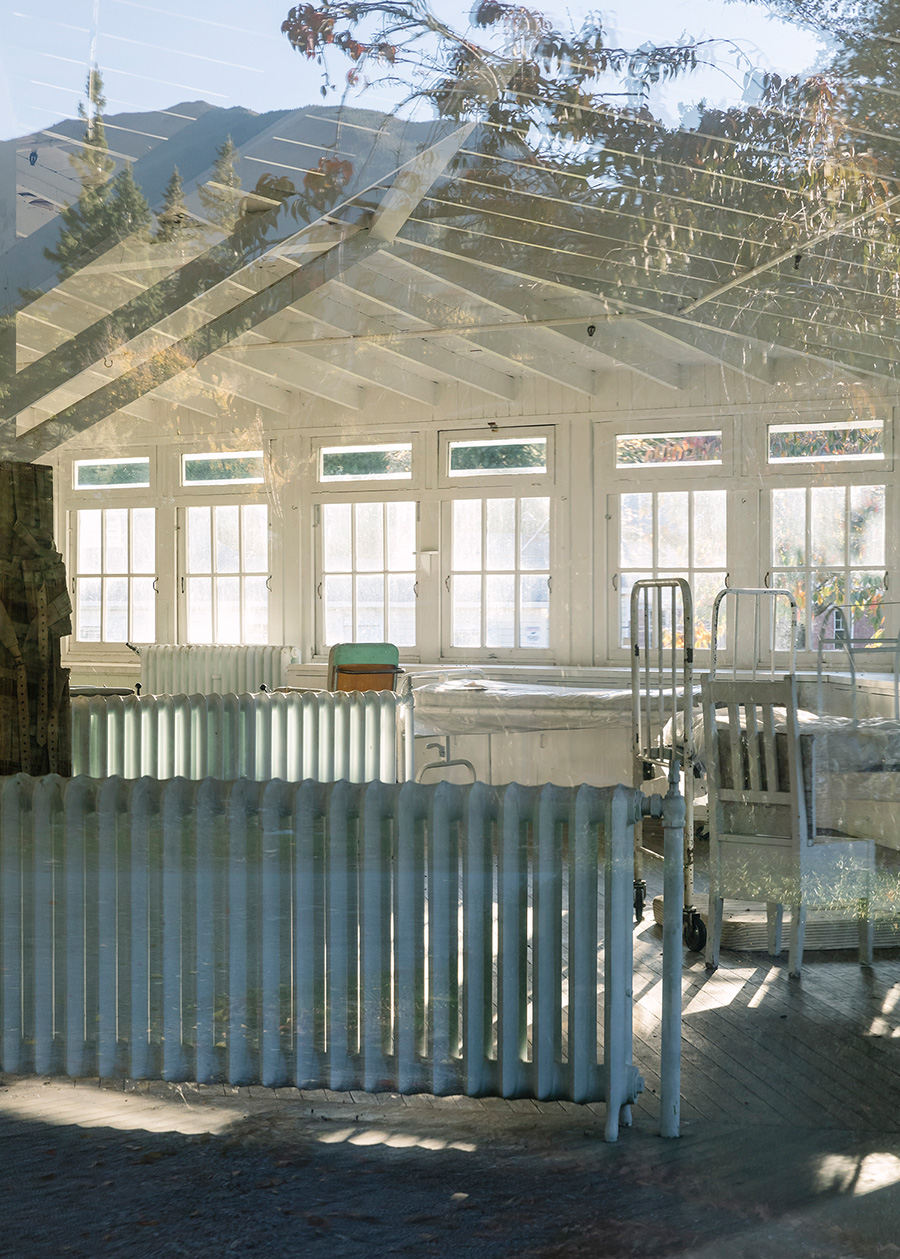
A Call for Care
Residential care facilities for the treatment of mental health or addiction have fallen out of favour. As one such place, the Queen Mary Hospital in Hanmer Springs, continues to deteriorate, many are asking if it’s time to restore it to its original purpose or at least honour its World War I history.
By Sally Blundell
Photographs by Sarah Rowlands
It was a fire sale. Beds, bedside tables, wicker chairs, kitchen appliances, pillows, blankets, outdoor seating dating back to World War I. Over two days, says Hanmer Springs local historian Rosemary Ensor, anything that wasn’t nailed down went under the hammer. “They auctioned off everything — people bought things for a song.”
It was early 2004 and the lights were going out at Queen Mary Hospital in Hanmer Springs. Since 1916 the massive 15-hectare site close to the popular thermal pools has housed a sanatorium, a military hospital for World War I soldiers diagnosed with shell-shock, a hospital for nervous disorders, a psychotherapeutic treatment clinic for alcohol and drug addiction and a kaupapa Māori mental health programme. In each of these roles, the hospital represented innovative, humane and empathetic care in a stunning alpine environment.
“The sheer beauty of the place saved my mind,” wrote journalist and novelist Iris Wilkinson (Robin Hyde) of her brief stay at Queen Mary Hospital in 1927. “Do you know it? The hospital is a white slate-roofed crescent. In the grounds, daffodils and crocus burst up, a thousand flames, from the soil. The evening light on the mountains was that incredible Eastern blue that I saw here, from this room’s wide windows.”
“Going into the place, I actually felt a sense of hope straight away,” recalls award-winning artist Ewan McDougall nearly a century later. “It was the big view of the mountains, the fact that people seemed to be turning their lives around — it really had a palpable feeling of ‘this is your chance’.”
Now, the rooms stand empty, the result of changing economic ideologies as much as medical best practice. Tourists, wrinkly-skinned from their dip in the hot pools, wander through mature linden trees, sequoia, redwoods, ashes and oaks, or peer through the windows into the abandoned timber-panelled bedrooms of the 1926 Chisholm Ward or the light-filled spaces of the Soldiers Block, now places for possums, vandals and a fading album of memories.
Further back from Hanmer’s busy main road, a chain-linked fence marks the 2010 boundary separating the southern non-heritage land, still owned by the Ministry of Health but currently up for sale. On this side of the fence, ancillary buildings are in a state of deterioration, the gardens are overgrown. The Rutherford Ward, built as a ward for male patients in 1940, stands desolate.
The heritage-listed northern part of the original grounds, now owned by the Department of Conservation, is vested in the Hurunui District Council to look after and put to good use.
What that use should be is still debated. With recent calls from the health sector for more residential services for people with alcohol and drug addiction, some say it is time to restore the once-important treatment centre, and with practical upgrades, use it again to deal not only with addiction but also with mental health services. Robert Crawford, the former medical superintendent of Queen Mary who died last year, called repeatedly to have the centre reopen as an addiction hospital, but his entreaties were ignored.
At the same time, momentum is building for a new plan to refurbish and repurpose the historic Soldiers Block, now at risk of slow decay, as a visitor attraction and community centre telling the story of the progressive treatment of mental health and addiction in this country.
For the site’s nominal caretaker, finding a use — any use — for these buildings is proving difficult. Recent attempts by the Hurunui District Council to find a leasee or operator to run a luxury day spa in the Chisholm Ward have come back empty-handed.
Two recent funding applications to earthquake-strengthen and renovate the distinctive 1916 Soldiers Block, the first step towards a major rejuvenation project incorporating a Weta Workshop-designed museum telling the stories of returning soldiers, the long-standing relationship with Ngāi Tahu hapū Ngāti Kurī, and the innovative treatment of drug addiction, have been declined.
Now, as private benefactors and some councils pitch in to fund another Weta-designed “living museum” in Le Quesnoy over 18,000 kilometres away — the site of a courageous battle by the NZ Rifle Brigade to liberate the medieval French town in 1918 — the Hurunui District Council is putting together a third funding application to help retain and repurpose the distinctive architecture and rich history of the former hospital.
“So many people from all over the country have connections with aspects of this site,” says Hurunui District Council chief executive Hamish Dobbie. “But the longer it is closed, the more distant that gets. The biggest risk is lack of use. Buildings are no good to anyone if no one can get inside them — it is all very nice to walk around the outside but to actually give a building life it needs to serve a purpose.”
For the Kaikōura-based Ngāti Kurī, the connections with the hospital, mainly through the Taha Māori programme, run deep. “Each month patients would be welcomed at the Takahanga Marae in Kaikōura,” says Te Rūnanga o Kaikōura cultural pou chair Maurice Manawatu. “Those connections are still strong today, with people from all over the country. Our dream was always to have our footprint there somewhere.”
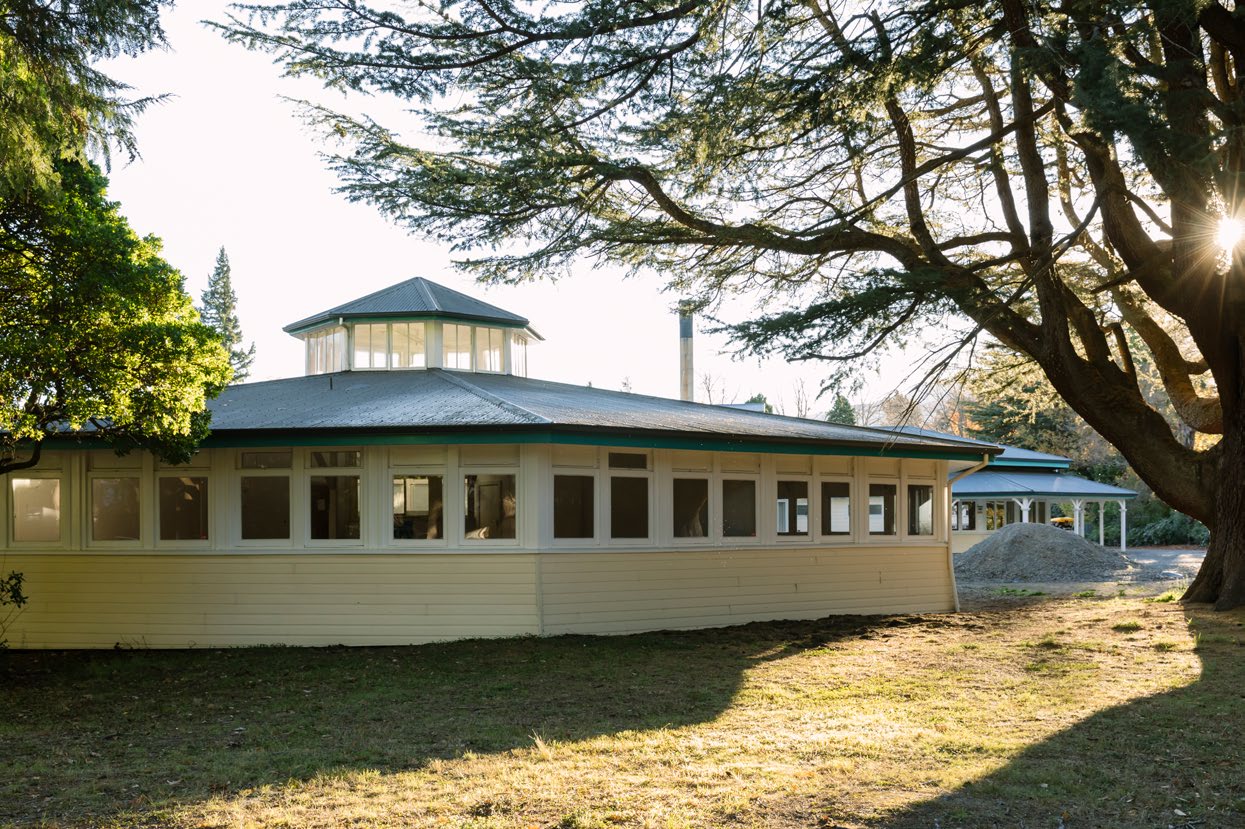
The unusual octagonal structure of the Soldiers Block, devised to maximise fresh air and light to assist the psychologic recovery of traumatised soldiers.
Early Māori knew the natural occurring springs in this remote, subalpine region as Te Whaka takaka o te karehu o te ahi a Tamatea, “the resting place of the embers of the fires of Tamatea”, a waypoint between Canterbury and the West Coast and an inland site for mahinga kai. In 1860 the Nelson Provincial Government proclaimed 1072 hectares of the land as a reserve. Two decades later, the provincial government established a sanatorium, becoming one of three spas, after Rotorua and Te Aroha, attending to visitors of “fragile health”.
When this burned down in 1914, the government decided to take advantage of the health-giving properties of the thermal springs for a new hospital managed by the Defence Department for soldiers suffering from what was then called shell-shock or war neurosis. It would be a place of peace and nurture, a necessary alternative to mental asylums and a riposte against those who regarded the very real impact of trauma as a malaise invented, as Regeneration author Pat Barker wrote so forcefully, by “cowards”, “shirkers” and “scrimshakers”.
The Queen Mary Hospital for Sick and Wounded Soldiers was opened in 1916, close to the hot pools and extending into the original reserve to include a working farm. In keeping with new ideas around the importance of sunlight, fresh air and good ventilation, its innovative structure comprised two large octagonal buildings, each with a smaller ‘lantern’ room in the centre where nursing staff could keep watch. This design was also used in military hospitals in Featherston, Trentham and Rotorua but of these, the Soldiers Block at Queen Mary is the only example to survive intact.
Medical records from before 1943 have been destroyed or lost — a fate not uncommon before the passing of the Archives Act in 1957 — but records since then present a catalogue of war-induced trauma: headaches, giddiness, insomnia, shakiness, “queer turns of drowsiness”, nightmares. John, a turner and fitter (files were made available to North & South on the condition that first names only be used), suffered attacks of trembling and chronic dyspepsia after being blown out of a Bren gun carrier in El Alamein in 1942. His marriage had ended, he was fearful he would not be able to return to work, he was drinking heavily.
One of Queen Mary’s earliest patients was Christchurch carpenter Percy Morse, a young trooper with the Canterbury Mounted Rifles who suffered “shell concussion” in Gallipoli. It seems Morse got some respite during his time at the Queen Mary Hospital for Sick and Wounded Soldiers — he is mentioned in a Lyttelton Times report as playing the mandolin during a day of entertainment — but the long shadow of trauma lingered. In June 1944, a year after his son, an RNZAF flying officer, was killed in Germany, Morse went outside. Ten minutes later, his wife Mary heard a gunshot.
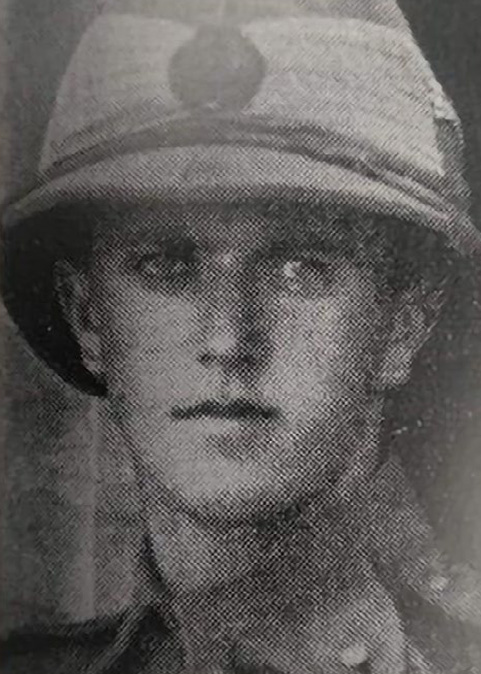
Photo: Beattie, P.J. & Pomeroy, M. (2013-2020).
“Even though they were treating these men for PTSD, alcohol played a big part in those men’s lives,” says Rosemary Ensor, who moved to Hanmer in 1964 as a young teacher. “If you were going over the top you would have a tot of something to get you over here. Even after World War II, many came back addicted — uppers to fly and alcohol for the ground troops.”
Medication was supplemented by a programme of daily walks, dips in the hot pools, massage, rest on the verandah, gardening, working in the carpentry workshop or on the farm.
“They were encouraged to live again, to try and make themselves whole again,” says Ensor. “They had a metal workshop and woodworking workshop; they made slippers from wool shorn from the sheep on the farm. They grew their own vegetables, they had their own orchards and pigs, hens, dairy cows, sheep.”
From 1921, when the military passed responsibility for the hospital on to the Department of Health, it became a respected centre for the treatment of “functional nervous disorders” such as anxiety disorder, depression (according to a 2004 heritage assessment by Opus Consultants, Queen Mary may have been the first place in New Zealand to use electroconvulsive therapy to improve mood), alcohol abuse and, later, drug dependency for both former soldiers and, increasingly, civilians. To meet the growing demand, the government added a new women’s ward, later called the Chisholm Ward, a low-lying, sunny, verandahed building far removed from the austere demeanour of psychiatric institutions such as Sunnyside Hospital in Christchurch and the Seacliff Lunatic Asylum in North Otago.
Under the direction of Dr Tom Maling then Dr Robert Crawford, the hospital consolidated its reputation as an empathetic and innovative treatment centre, building on the 12-step programme used by Alcoholics Anonymous to include new psychotherapeutic “talking therapy” techniques such as psychodrama, grief groups and family weeks as well as occupational therapy and relaxation groups.
There was a strict no-booze rule — one slip and you were out — but there were no fences; admission was voluntary (Queen Mary Hospital was never gazetted for compulsory treatment under the Mental Health Act); and patients were encouraged to explore the township and surrounding landscape. As Crawford wrote in 2008, “Queen Mary Hospital must rank as one of the most beautiful healing environments any hospital could wish for. The current emphasis on drug therapy in mental health has obscured the healing properties of peace and tranquillity.”
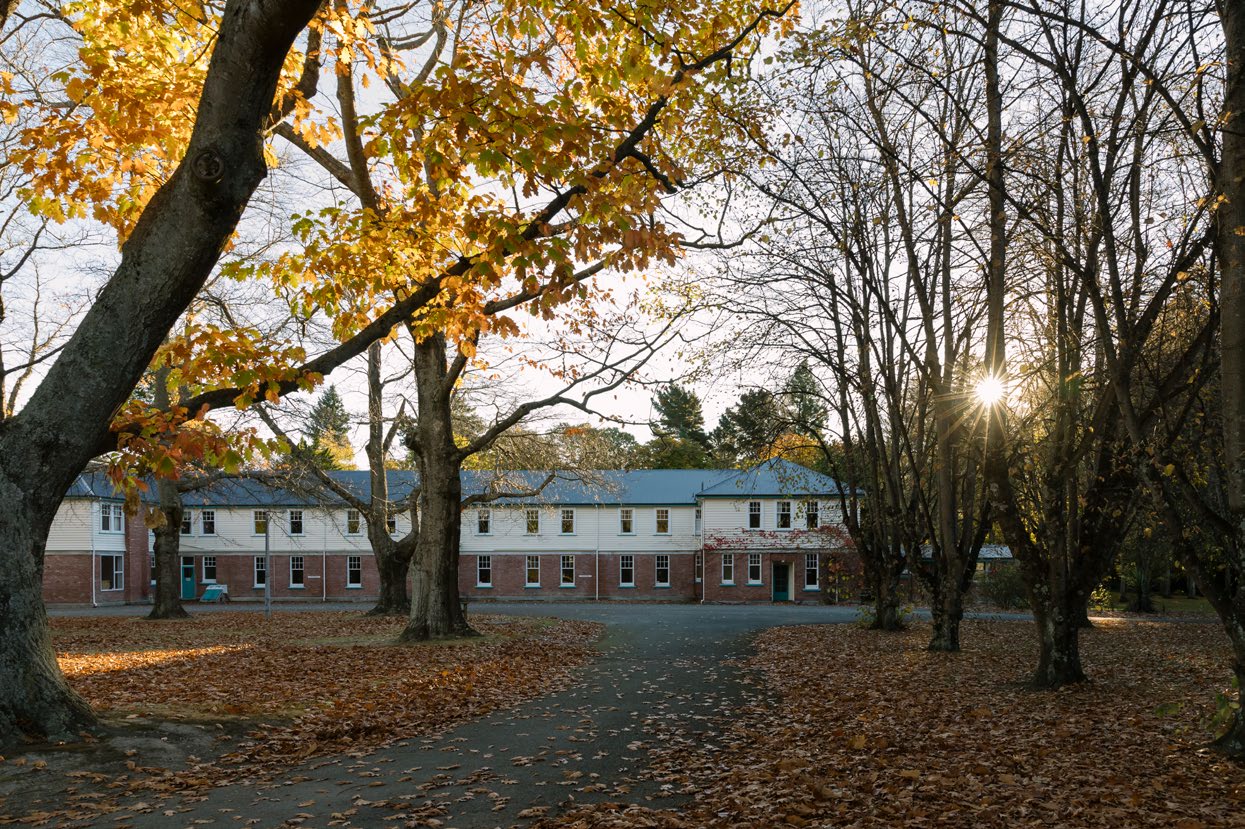
The 1929 Nurses’ Home.
Heather Muir, now a district nurse on the West Coast, began work at the Queen Mary Hospital in 1977. After the “authoritarian nursing system” of Christchurch Hospital, she says, she was drawn to the “more therapeutic way of working with people”. Although patients were expected to have gone through a period of abstinence before arriving, some who came in on the bus were still undergoing withdrawal. “Our responsibility was around medication,” says Muir, “and making sure people were physically well. But we also did relaxation therapy, other nurses moved into group therapy — everyone was a therapist up there then.”
Some patients didn’t enjoy it, she says; for others it was life-changing. “Their brains had been in a fog and for the first time they could think about who they were, where they were, what they wanted to do. There was a great cross-section of people: business people, priests, upper-crust ladies — people who probably never mixed together before but there was no judgement. Some people needed more than one go and that was okay — it was a pretty big change — but it was important for families and a big saving for the health sector.”
After a drunken night ended in a fractured neck at a bikie clubhouse in Taranaki, Ewan McDougall found himself in the hands of the health system. On moving to Dunedin with his wife Sarah, he was referred to the Centre for Alcohol Disabilities and from there to Queen Mary Hospital.
This was summer, 1988. An academic career teaching political science at Otago had long been left behind; now his job on an oil rig was over. His future was uncertain but still he was reluctant. “I had a wife and two kids and was happily married,” he says. “But I was needing to use drugs daily and not getting the kick off them anymore — the fun left some time in Dunedin when I was playing rock ’n’ roll in the 70s. Then we had another of [our] innumerable fights and Sarah said, ‘If you don’t go and do something about your drinking our marriage is over.’ I didn’t want that to happen.” The bus trip was interminable. At each stop — Waikouaiti, Oamaru, Timaru — McDougall was tempted to get off, but he stayed on board until the bus reached the hospital grounds.
“When I went in there I was very suicidal. I was coming from a pretty dark and horrible place, a place of addiction and anger. Nothing was working anymore.”
As an atheist, he was not impressed by the religious overtones of the 12-step programme, “but as soon as I got there I realised, this is time when I get to work on myself, and I was surrounded by other people on that journey. We are social beings, I think — the idea of man alone didn’t work for me, it put me in a hole.”
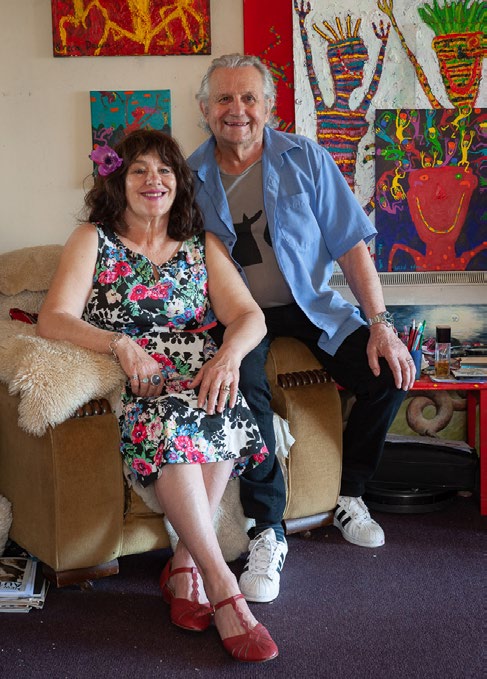
Ewan and Sarah McDougall, who both underwent treatment programmes at Queen Mary. Photo: Courtesy of Ewan McDougal.
When Crawford learned of his interest in art, he asked McDougall to paint a wall in the Rutherford Ward. “I walked out of that room, thinking, man, this is what I am going to do. As soon as I got home I chucked the lawnmower out of the shed, set up a studio and went for it. There was no way I was going to walk out of there and go to a pub. I really haven’t stopped painting since.”
After attending family week at Queen Mary with her husband, Sarah also took stock of her own addictions. “I was thinking it was all his fault, but when he went away for treatment I still couldn’t make a day without using — it doesn’t matter what it was: wet, dry, powder, prescribed.” After completing her own eight-week programme, Sarah, who had left school in the United Kingdom at the age of 12, went on to complete a Master of Fine Arts at the University of Otago and has since pursued a successful career as a playwright and poet. “Everything changed for me. This really did save our life.”
In 1990, in conjunction with kaupapa Māori therapist Monica Stockdale (Ngāti Kahungunu) and Dr Jock Sutherland, Crawford established New Zealand’s first Taha Māori treatment programme, Te Aroha o te Hauangiangi (“warm and gentle breeze of love”), with the establishment of first a wharenui then a smaller whare iti in the Soldiers Block.
In keeping with this programme, a “spiritual garden” was built in the southwest corner of the site, comprising four pou carved by patients, native plantings (in contrast to the mainly exotic surrounding forest), sculptures and a small ring of stones, in which patients finishing their term at the hospital could burn their personal stories.
By this time, however, pressure on health funding was building. To cut costs, first the farm was closed down; then the mineral pools, previously part of the hospital complex, were placed under the responsibility of the council. In 1991 the Canterbury Area Health Board closed the Chisholm Ward. After 15 years at the helm, Crawford resigned in protest.
A report that year from the Alcoholic Liquor Advice Council, co-authored by Mental Health Foundation Chair Max Abbott, praised the tranquil, healing environment, the high-quality programme, the innovation and staff commitment shown at Queen Mary Hospital. But it also noted the long waiting list (a long waiting list was also described as a plus), the remote location, the hospital’s seeming resistance to “other treatment philosophies”. The Queen Mary programme adhered to the Minnesota model of inpatient drug treatment, a “disease” model by which certain people are considered uniquely and irrevocably vulnerable to alcohol and incapable of controlling their consumption and lifelong abstinence is the only option. Although some observers, Abbott wrote, suggested the Queen Mary Hospital model was more eclectic than this, “It is clear however that Queen Mary Hospital is firmly based on an objective of abstinence, identification as an alcoholic (or drug addict) and a spiritual emphasis.”
But success could only be judged, the report stressed, after a full investigation into the longterm effectiveness of the programme on ex-clients’ behaviour. As superintendent, Crawford had recognised this. As he told radio broadcaster Neville Glasgow in 1989, follow-up studies to the “talking treatment” offered by the hospital “are very favourable by world standards” but they could be a lot more rigorous — “maybe one day we will get around to doing that, given the funds”.
Those funds did not eventuate.
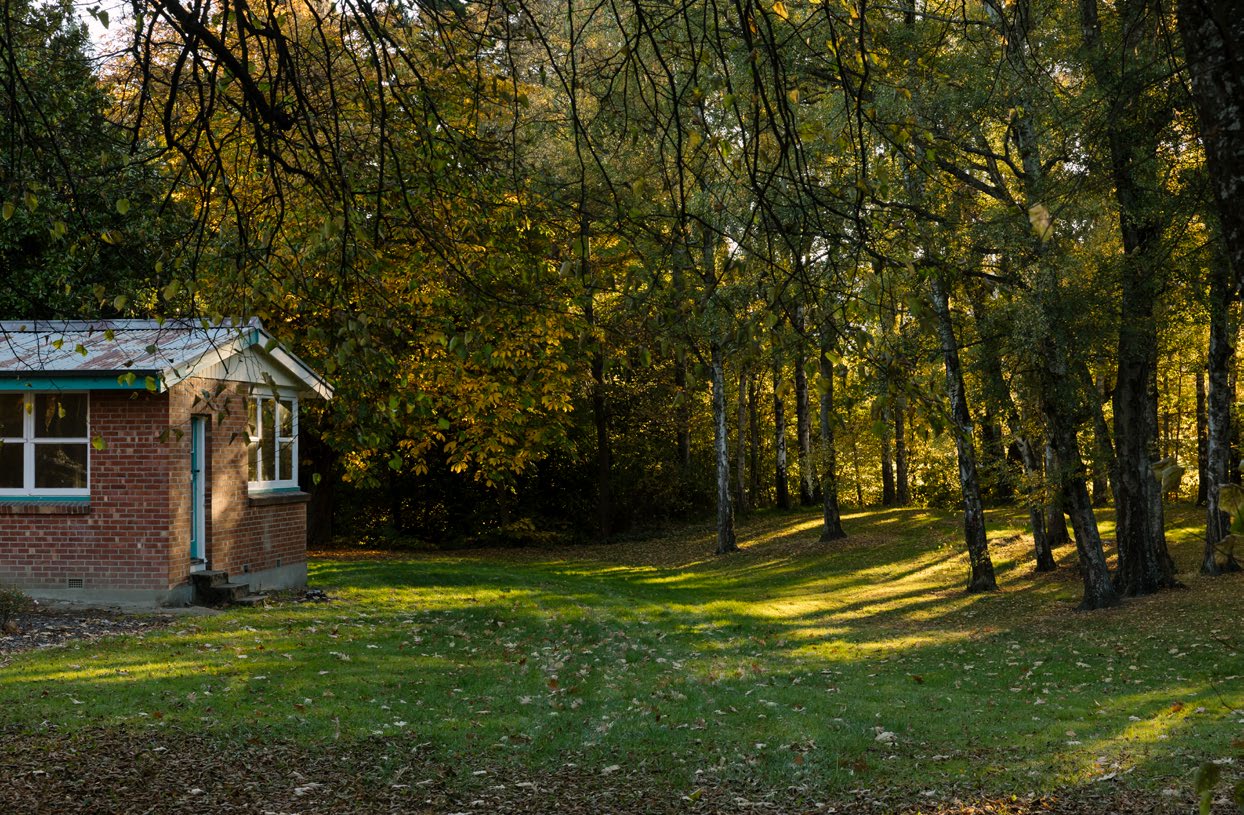
The single story end of the Nurses’ Home (1929) surrounded by exotic forest
The following decade saw a raft of significant changes within the health sector. Under a new system of regional health authorities, later combined into the single Health Funding Authority, the roles of purchasing and provision of health services were separated. Over the following tumultuous years, successive governments saw area health boards reconfigured into crown health enterprises and then district health boards. These also took over responsibility for funding alcohol treatment services from the national Alcoholic Liquor Advisory Council agency.
It was a competitive, quasi-market, decentralised approach, a square hole for the round peg of a national treatment centre such as Queen Mary Hospital that drew most of its clients from outside the Canterbury Area Health Board region.
In 1997 Crown health enterprise Healthlink South sold the addiction clinic operation to businessmen Rob Fenwick and John Beattie, major shareholders of Hanmer Institute Ltd. The company struggled financially and in April 2003 the assets were transferred to a new charitable company, Hanmer Clinics. In November 2003, the contract between the Ministry of Health and the Hanmer Springs addiction clinic ended. Queen Mary Hospital finally shut its doors.
The shock was palpable. The following year, 6370 people signed a petition organised by Crawford requesting the hospital land remain under Crown ownership. “He was hoping to keep it as a hospital,” says Ensor. “It was terrible for him, it was like losing a partner.”
But the tide was turning on residential health care for mental health and addiction. A 2001 Ministry of Health background paper recommended the strengthening of community-based non-residential alcohol and drug treatment services as the first response to the prevention and reduction of alcohol and drug use-related problems. Residential treatment, it said, “is generally accepted by most of the alcohol and drug sector as not being the first treatment of choice for most people with alcohol and drug-related problems”. Rather, it said, it was more appropriate “when there have been a number of previous failed attempts at non-residential treatment”.
It is difficult to find supporting data for this. As both Crawford and Abbott had noted, there was a paucity of research into the outcome of former Queen Mary Hospital patients. For some, such as McDougall, moving away from their social networks was key to recovery. “I really had to get away from home, from Sarah, from my friends. As much as they might say it’s really good to see you changing, they really wanted to see you back in the bar. It is very strong, that tribal thing — I needed to get right away from all of that.”
Professor Doug Sellman is chair in Psychiatry and Addiction Medicine, University of Otago, Christchurch. One of the great advantages of inpatient or residential services, he says in an email exchange about Queen Mary, “is that withdrawal from the drug (most important being alcohol) and initiating an abstinence-based recovery, which is by far the best strategy for the vast majority of people with severe drug addiction . . . is most effectively achieved when a person is admitted to an inpatient/residential unit”.
“He was hoping to keep it as a hospital,” says Ensor. “It was terrible for him, it was like losing a partner.”
While there was an expansion of outpatient services, he says, particularly for improving access to assessment, “there was a serious reduction in backup inpatient/ residential services for those who continue to struggle with recovery on an outpatient basis. And there was no greater loss than that of Queen Mary Hospital.”
This loss has never been fully mitigated. According to the Government Inquiry into Mental Health and Addiction in 2018, the demand for addiction services is increasing, “yet very little has been invested into services such as residential treatment”.
The number of residential beds for people recovering from addiction has fallen from 1355 in 1991, to 519 in 2001–02, to 479 in 2015–16, mostly run by charities or private companies. Bed numbers in some residential facilities are beginning to increase — this year’s budget included an extra $27 million over four years for community-based crisis services, including residential care. But, as Sellman notes, over this same 30-year period the New Zealand population has grown from 3.5 million to 5.1 million, there’s been a 10 per cent increase in the per capita consumption of alcohol and an acceleration in the use of methamphetamine.
“Ideally anyone who is still struggling on an outpatient/day patient treatment programme to get on a path of recovery,” he says, “should be offered an inpatient/residential option.”
A recent report from the new Mental Health and Wellbeing Commission calls for “greater choice around acute and crisis care and expanded use of peer services and community providers”, but residential care does not seem high on its agenda. As chief executive Karen Orsborn says, the commission advocates for a health and wellbeing approach “that aims to reduce harm from use, rather than requiring abstinence”. Harm from alcohol and other drugs, she adds, “cannot be addressed in isolation from the social factors and environments that make people and whānau more at risk from experiencing poorer wellbeing outcomes.
“We advocate for actions to minimise harm, such as expanding the support options available for people experiencing alcohol and other drug harm. This includes increasing access to crisis cafes — safe places that people experiencing alcohol and other drug harm can go to access support — and expanding access to high-quality crisis respite services.”
As Crawford and Abbott noted 30 years ago, Orsborn also acknowledges that the most recent comprehensive data on the prevalence of harm from substances is from 2006: “It is difficult to know how many residential beds are needed without current prevalence data, but we do know that residential treatment works well for some people and should be part of the options offered.”
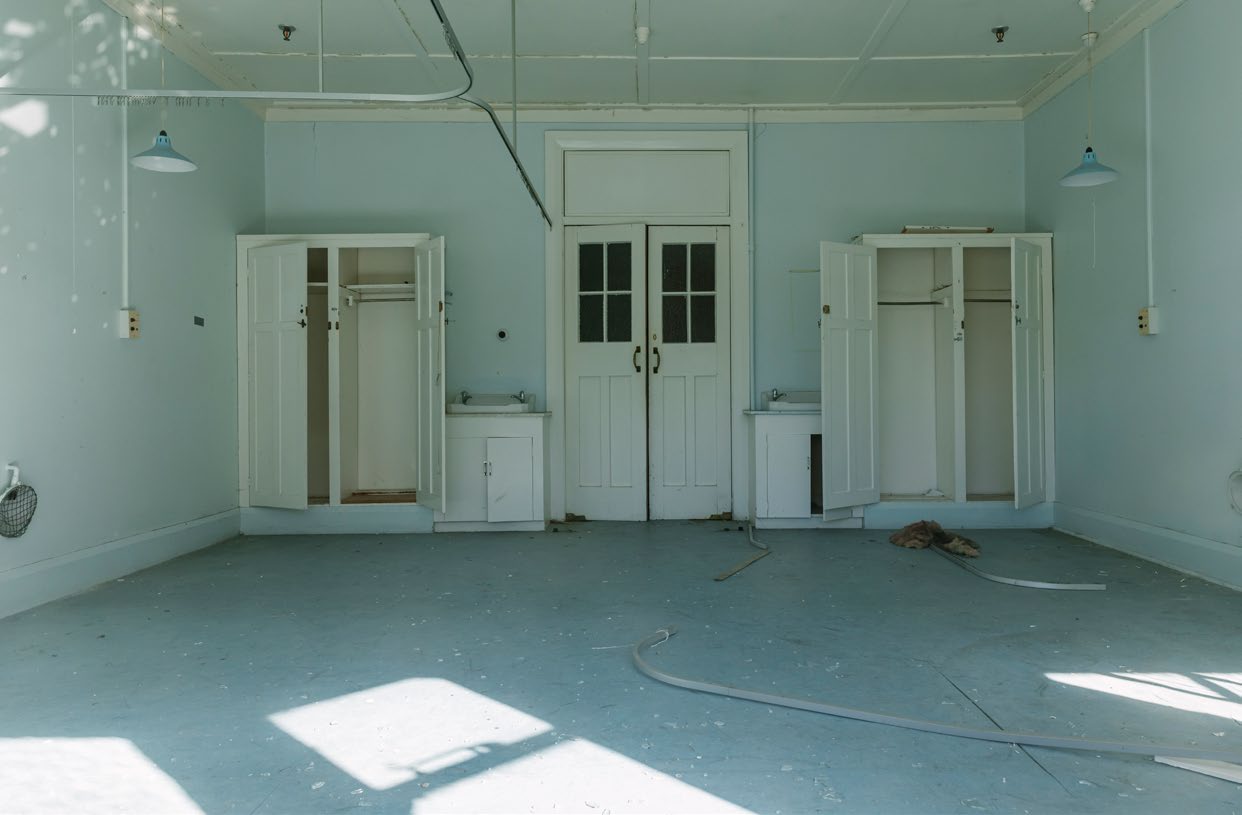
Part of the 1926 Chisholm Ward used for new admissions.
Despite the protests, in 2003 the future of the Queen Mary Hospital was looking bleak. The Canterbury District Health Board was keen to sell the whole site. For this it received clearance from the Department of Conservation, which had determined the land had “no natural values” (a later complaint to the Ombudsman found that Department of Conservation had failed to consider historic resources as well as natural resources).
A group of concerned residents, led by Crawford and Ensor, formed the Queen Mary Hospital Reserve Trust to keep the land in Crown ownership. “We didn’t want to see it divided into teeny-tiny sections and people building houses on it,” says Ensor. “It’s the other half of Hanmer.”
By this time the Hurunui District Council had indicated it was prepared to purchase all or part of the site. “The council at the time didn’t want the nurses’ building but it wanted the Soldiers Block and Chisholm Ward,” says chief executive Hamish Dobbie. “We thought it was really important to preserve the heritage and history of the site, and the idea that it would be sold on the open market — it didn’t sit well in Hanmer Springs and across the wider district.”
In the meantime, negotiations between the Canterbury District Health Board, the Hurunui District Council and Ngāi Tahu, who had first right of purchase of the site, were ongoing. An early agreement would have seen the whole of the ex-hospital land sold to Ngāi Tahu, with the northern portion of that land then on-sold to the council. Concurrently with these negotiations, the Hurunui District Council was lobbying the Crown to recognise and protect the national significance of the northern portion of the overall ex-hospital site.
An agreement was finally reached in 2008 by which the Crown Health Financing Agency would subdivide the property into the heritage (northern) and non-heritage (southern) areas. The northern area, including the Soldiers Block, Chisholm Ward and Nurses’ Home, would be transferred to the Department of Conservation as an historic area and a recreation reserve. These would then be vested in the Hurunui District Council.
The subdivision, says Christine Whybrew, acting director of Heritage New Zealand Pouhere Taonga southern region, recognised the higher heritage value of these three buildings, the surrounding landscape and their proximity to a tourist attraction — the site now has two heritage registrations, one as an historic area and the other as the Heritage NZ Category 1-listed former Queen Mary Hospital. But it also left the 1940 Rutherford Ward and what remained of the spiritual garden in the unprotected southern portion, now for sale through Land Information New Zealand. But as Whybrew explains, a line had to be drawn somewhere. “There had to be some pragmatism that recognised the Ministry of Health needed to make some return on the land that was no longer of use.”
Under this agreement (which technically lapsed in 2019 but “sort of rolls over”, says Dobbie), the council was charged with maintaining and protecting the site’s historic values “for sustainable and viable commercial and/or community uses”.
In keeping with its Reserve Management Plan for the historic site, required under the Reserves Act 1977, any such use should be consistent with the concept of “wellness”.
It is, agrees Dobbie, a wide brief. “Anything can be wellness, it is quite an encompassing terminology, but the concept is in keeping with the history of the site. Bathing, rehabilitation, treating addictions — all of those are about people’s mental and physical health. Under the old concept of a sanatorium in Edwardian times, massage and water treatments — they were all part of that experience.”
In 2012, the council asked Bayleys real estate agency to test the market for a tenant for the Chisholm Ward, advertising it as suitable for an upmarket European-style health spa, gallery or educational facility.
There was no interest.
In 2015 Hanmer Springs Thermal Pools sought partners for a $15 million high-end spa investment, including inside and outside pools, a steam room and ice cave.
Again, says Dobbie, it came away empty-handed.
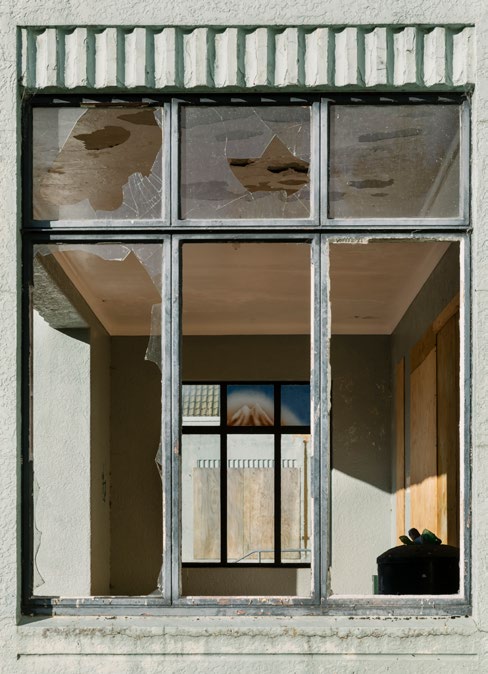
Broken windows and peeling ceilings — costly outcomes of the ongoing disuse of the Queen Mary Hospital.
In the meantime, the Hurunui District Council was busy working on a new use for the historic Soldiers Block. In 2020 it announced a $7.3 million plan to renovate and repurpose the building into a community centre, function space, café, movie theatre and “war experience” to tell the many stories of those who had passed through its walls. When its application to the Lotteries Special Projects Fund for two-thirds of this amount was declined, it began work on a scaled-down version. This year it pledged $1,076,000 from its own Queen Mary Development Contribution account and $250,000 from the council earthquake-strengthening account towards a more modest project to strengthen, renovate and upgrade the Soldiers Block. This would be the first step in developing a permanent interactive exhibition designed by Weta Workshop called “A Place of Light and Life”, telling the wartime, medical and, in conjunction with Takahanga Marae in Kaikōura, Taha Māori story of the building. The cost, a more achievable $4.5 million.
Such strengthening and repair work, wrote Whybrew in support of the application, would “finally ensure this important heritage place has links once again with the local, regional and national community”.
Again, the funding application was declined.
Hurunui is a spread-out district, the seventh largest in the country, but with low population density. The council gathers funds for the Queen Mary project from development contributions charged on new subdivision or building consents but maintenance costs alone are high — already it spends $100,000 a year (cut to $50,000 for 2021) to cover security, grounds maintenance, repair of broken windows and cleaning gutters. The pools could extend further into the site — “but the council has to be careful that it balances the historic reserve and its own commercial demands from the pools,” says Dobbie.
As interest in heritage tourism grows — in the first summer after lockdown Heritage NZ properties in the South Island had their highest visitor rates ever — could it be purchased by the heritage agency? Whybrew won’t be drawn. “I couldn’t say,” she says.
Despite the many setbacks, the council is optimistic. Dobbie is still hopeful an operator can be found to run the Chisholm Ward as some form of day spa, a type of “wellness” activity already popular overseas.
“When we talk about day spas there are beauty spas which tend to rely on facial treatments, beautification, manicures . . . and then there is the European spa experience which is more about massage and relaxation — it’s good for your mental health to be pampered occasionally.” An overnight retreat? “It is something we have considered, although you are into a different market again with that. If a developer came along tomorrow and said we’d like to make it a spa retreat, then we’d have to have the conversation.”
In the meantime, the council is preparing a further application for funding to earthquake-strengthen the Soldiers Block.
“The intention is still to proceed,” says Hurunui District Council manager of regulatory services Judith Batchelor. “We now have about $1.3 million [to put towards the project] so we’re working out what we can get with that — we don’t want to start the work then run out of money. So the project is still very much alive, then we’ll see if we can get funding for the Weta concept.”
The ‘other’ Weta concept, the new war memorial museum planned for a former gendarmerie in Le Quesnoy, has now raised $9 million of the required $15 million. A tough comparison?
“The Le Quesnoy concept is really great,” says Dobbie. “It’s about honouring those soldiers who did what they did at the time. Ours is not about war — it is about the impact of war on real people who might not have been heroes but who went out and did their bit and the people who helped them recover from that. You probably won’t find a site dedicated to World War I nurses but they were just as much a part of the effort.”
But the clock is ticking.
“There are fewer people now who remember the hospital as a hospital,” says Dobbie. “More people remember it as a site that is looking quite forlorn. That tends to change people’s views over time.”
Sally Blundell is an award-winning writer based in Ōtautahi Christchurch.
This story appeared in the August 2022 issue of North & South.


